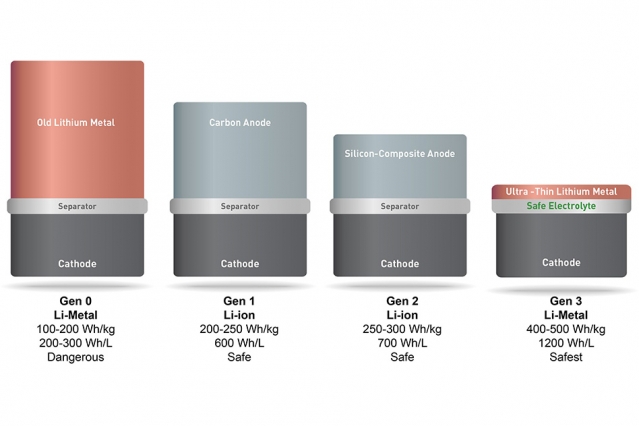The battery essentially swaps out a common battery anode material, graphite, for very thin, high-energy lithium-metal foil, which can hold more ions — and, therefore, provide more energy capacity. Chemical modifications to the electrolyte also make the typically short-lived and volatile lithium metal batteries rechargeable and safer to use. Moreover, the batteries are made using existing lithium ion manufacturing equipment, which makes them scalable.
SolidEnergy plans to bring the batteries to smartphones and wearables in early 2017, and to electric cars in 2018. But the first application will be drones, coming this November. “Several customers are using drones and balloons to provide free Internet to the developing world, and to survey for disaster relief,” Hu says. “It’s a very exciting and noble application.”
Putting these new batteries in electric vehicles as well could represent “a huge societal impact,” Hu says: “Industry standard is that electric vehicles need to go at least 200 miles on a single charge. We can make the battery half the size and half the weight, and it will travel the same distance, or we can make it the same size and same weight, and now it will go 400 miles on a single charge.”
SolidEnergy Systems’ battery (far right) is twice as energy-dense, yet just as safe and long-lasting as the lithium ion batteries used in consumer electronics. The battery uses a lithium metal foil for an anode, which can hold more ions and is several times thinner and lighter than traditional lithium metal, graphite, carbon, or silicon anodes. A novel electrolyte also keeps the battery from heating up and catching fire. Courtesy of SolidEnergy Systems
Solid Energy Systems shows what a replacement battery for the iPhone would look like
After three years of sharing A123’s space in Waltham, SolidEnergy this month moved its headquarters to a brand new, state-of-the-art pilot facility in Woburn that’s 10 times larger — and “can house the wings of a Boeing 747” Hu says — with aims of ramping up production for their November launch.
SOURCE- MIT News, Solid energy Systems,

Brian Wang is a Futurist Thought Leader and a popular Science blogger with 1 million readers per month. His blog Nextbigfuture.com is ranked #1 Science News Blog. It covers many disruptive technology and trends including Space, Robotics, Artificial Intelligence, Medicine, Anti-aging Biotechnology, and Nanotechnology.
Known for identifying cutting edge technologies, he is currently a Co-Founder of a startup and fundraiser for high potential early-stage companies. He is the Head of Research for Allocations for deep technology investments and an Angel Investor at Space Angels.
A frequent speaker at corporations, he has been a TEDx speaker, a Singularity University speaker and guest at numerous interviews for radio and podcasts. He is open to public speaking and advising engagements.



